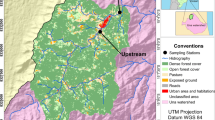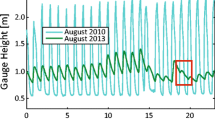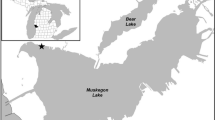Abstract
The changes in both physical and chemical properties of interstitial water were investigated within a large gravel bar to determine if the parafluvial zone was a hotspot for nutrient transformations in a lowland eutrophic river, the Doubs (Eastern France). Interstitial water was sampled in 30 piezometers along five transects across the gravel bar, surface water was sampled in main and chute channels. Five campaigns of sampling were performed among summer and winter. In both interstitial and surface samples, water chemistry (electrical conductivity, pH, chloride, dissolved oxygen concentrations—DO) and nutrient concentrations (nitrate—NO3 −, ammonium—NH4 +, soluble reactive phosphorus—SRP, dissolved organic carbon—DOC) were measured. Moreover, temperature, water level, sediment grain size distribution and total bacterial abundance were assessed along a flowpath through a lateral gravel bar of the Doubs River. Measurements of water table elevation in the bar, main and chute channels indicated that the parafluvial flowpath was perpendicular to the main channel. Very low changes in chloride concentration and electrical conductivity showed minor groundwater input along the flowpath. The parafluvial zone was 0.9 m thick under the mean piezometric level, hydraulic gradients along the flowpath were 0.3%, and the discharge of interstitial water through the bar calculated at low flow was 40.6 m3 day−1. Most changes in interstitial nutrients occurred during the warm season, suggesting that biotic mechanisms occurred. Along the flowpath, DO, DOC, and bacterial abundance declined, while phosphate increased. Temporal trends of nitrate were less clear, exhibiting a slight increase during spring (organic matter biodegradation) and a decrease during summer (denitrification). Using the parafluvial discharge and nutrient concentrations of water infiltrating into and seeping from the gravel bar, the retention capacity of the bar was 171 gC day−1 for DOC and 48.3 gN day−1 for nitrate. Phosphate production ranged from 0.65 to 2.3 gP day−1. These values were low compared to the nutrient fluxes in the river Doubs, suggesting a minimal local impact of the parafluvial zone in regulating of river pollution.








Similar content being viewed by others
References
Agence de l’Eau, R. M. C, 2006. Données et informations sur la qualité des eaux, l’état les milieux aquatiques, la pollution, les risques liés à l’eau et la politique de gestion de l’eau. http://rdb.eaurmc.fr/ .
Anbutsu, K., T. Nakajima, Y. Takemon, K. Tanida, N. Goto & O. Mitamura, 2006. Distribution of biogeochemical compounds in interstitial and surface standing water bodies in the gravel bar of the Kizu River, Japan. Archiv für Hydrobiologie 166: 145–167.
Battin, T. J., L. A. Kaplan, J. D. Newbold & S. P. Hendricks, 2003. A mixing model analysis of stream solute dynamics and the contribution of a hyporheic zone to ecosystem function. Freshwater Biology 48: 995–1014.
Bluck, B. J., 1974. Structure and directional properties of some valley sandur deposits in Southern Iceland. Sedimentology 21: 533–554.
Bonvallet Garay, S., S. Sauvage & P. Vervier, 2001. Hydromorphological control of phosphorus in a large free-flowing gravel bed river: The Garonne River (France). River Research and Applications 17: 461–472.
Bou, C., 1974. Les méthodes de récolte dans les eaux souterraines interstitielles. Annales de Spéléologie 29: 611–619.
Bravard, J. P., 1985. Le méandre de la Malourdie sur le Rhône court-circuité de Chautagne (Savoie), dynamique fluviale appliquée à l’écologie. Bulletin rhodanien de Géomorphologie 17–18: 3–16.
Bretschko, G. & M. Leichtfried, 1987. The determination of organic matter in river sediments. Archiv fuer Hydrobiologie 68: 403–417.
Burnham, K. P. & D. R. Anderson, 2002. Model Selection and Multimodel Inference: A Practical Information-Theoretic Approach. Springer, New York.
Cardenas, M. B. & V. A. Zlotnik, 2003. A simple constant-head injection test for streambed hydraulic conductivity estimation. Ground Water 41: 867–871.
Church, M. A., D. G. McLean & J. F. Wolcott, 1987. Sampling and analysis. In Thorne, C. R., J. C. Bathurst & R. D. Hey (eds), Sediment Transport in Gravel-Bed Rivers. Wiley, Chichester: 43–120.
Claret, C., 1998. A method based on artificial substrates to monitor hyporheic biofilm development. International Review of Hydrobiology 83: 135–143.
Claret, C., P. Marmonier, J. M. Boissier, D. Fontvieille & P. Blanc, 1997. Nutrient transfer between parafluvial interstitial water and river water: Influence of gravel bar heterogeneity. Freshwater Biology 37: 657–670.
Claret, C., P. Marmonier & J. P. Bravard, 1998. Seasonal dynamics of nutrient and biofilm in interstitial habitats of two contrasting riffles in a regulated large river. Aquatic Sciences 60: 33–55.
Coduto, D. P., 1999. Geotechnical Engineering, Principles and Practices. Prentice Hall, Upper Saddle River.
Dahm, C. N., N. B. Grimm, P. Marmonier, H. M. Valett & P. Vervier, 1998. Nutrient dynamics at the interface between surface waters and groundwaters. Freshwater Biology 40: 427–451.
Fauvet, G., C. Claret & P. Marmonier, 2001. Influence of benthic and interstitial processes on nutrient changes along a regulated reach of a large river (Rhône River, France). Hydrobiologia 445: 121–131.
Feris, K. P., P. W. Ramsey, C. Frazar, M. C. Rillig, J. E. Gannon & W. E. Holben, 2003. Structure and seasonal dynamics of hyporheic zone microbial communities in free-stone rivers of the Western United States. Microbial Ecology 46: 200–215.
Findlay, S. & W. V. Sobczak, 1996. Variability in removal of dissolved organic carbon in hyporheic sediments. Journal of the North American Benthological Society 15: 35–41.
Findlay, S., D. Strayer, C. Goumbala & K. Gould, 1993. Metabolism of streamwater dissolved organic carbon in the shallow hyporheic zone. Limnology and Oceanography 38: 1493–1499.
Grafen, A. & R. Hails, 2002. Modern Statistics for the Life Sciences. Learn How to Analyse your Experiments. Oxford University Press, Oxford.
Hendricks, S. P. & D. S. White, 1995. Seasonal biogeochemical patterns in surface water, subsurface hyporheic, and riparian ground water in a temperate stream ecosystem. Archiv für Hydrobiologie 134: 459–490.
Hill, A. R., C. F. Labadia & K. Sanmugadas, 1998. Hyporheic zone hydrology and nitrogen dynamics in relation to the streambed topography of a N-rich stream. Biogeochemistry 42: 285–310.
Holmes, R. M., S. G. Fisher & N. B. Grimm, 1994. Parafluvial nitrogen dynamics in a desert stream ecosystems. Journal of the North American Benthological Society 13: 468–478.
Holmes, R. M., S. G. Fisher, N. B. Grimm & B. J. Harper, 1998. The impact of flash floods on microbial distribution and biogeochemistry in the parafluvial zone of a desert stream. Freshwater Biology 40: 641–654.
Huggenberger, P., E. Hoehn, R. Beschta & W. Woessner, 1998. Abiotic aspects of channels and floodplains in riparian ecology. Freshwater Biology 40: 407–425.
Jones, J. B. & P. J. Mulholland (eds), 2000. Streams and Ground Waters. Academic Press, London.
Mainstone, C. P. & W. Parr, 2002. Phosphorus in rivers, ecology and management. Science of the Total Environment 282–283: 25–47.
Marmonier, P., D. Fontvieille, J. Gibert & V. Vanek, 1995. Distribution of dissolved organic carbon and bacteria at the interface between the Rhône River and its alluvial aquifer. Journal of the North American Benthological Society 14: 382–392.
Mermillod-Blondin, F., M. Creuze des Chatelliers, P. Marmonier & M. J. Dole-Olivier, 2000. Distribution of solutes, microbes and invertebrates in river sediments along a riffle-pool-riffle sequence. Freshwater Biology 44: 255–269.
Pinay, G., N. E. Haycock, C. Ruffinoni & R. M. Holmes, 1994. The role of denitrification in nitrogen removal in river corridors. In Mitsch, J. (ed.), Global Wetlands: Old World and New World. Elsevier Science, Amsterdam: 107–116.
Pinheiro, J. C. & D. M. Bates, 2000. Mixed-Effects Models in S and S-Plus. Springer, New York.
Pomeroy, L. R. & W. J. Wiebe, 2001. Temperature and substrates as interactive limiting factors for marine heterotrophic bacteria. Aquatic Microbial Ecology 23: 187–204.
Porter, K. G. & Y. S. Feig, 1980. The use of DAPI for identifying and counting aquatic microflora. Limnology and Oceanography 25: 943–948.
R-Development-Core-Team, 2005. R: A language and environment for statistical computing. R Foundation for statistical computing, Vienna, Austria.
Satoh, H., H. Ono, B. Rulin, J. Kamo, S. Okabe & K. I. Fukushi, 2004. Macroscale and microscale analyses of nitrification and denitrification in biofilms attached on membrane aerated biofilm reactors. Water Research 38: 1633–1641.
Schade, J. D., S. G. Fisher, N. B. Grimm & J. A. Seddon, 2001. The influence of a riparian shrub on nitrogen cycling in a Sonoran Desert stream. Ecology 82: 3363–3376.
Schulz, M. & C. Herzog, 2004. The influence of sorption processes on the phosphorus mass balance in a eutrophic german lowland river. Water Air and Soil Pollution 155: 291–301.
Sobczak, W. V. & S. Findlay, 2002. Variation in bioavailability of dissolved organic carbon among stream hyporheic flowpaths. Ecology 83: 3194–3209.
Sokal, R. R. & F. J. Rohlf, 1997. Biometry: The Principles and Practice of Statistics in Biological Research. W.H. Freeman and Company, New York.
Storey, R. G., D. D. Williams & R. R. Fulthorpe, 2004. Nitrogen processing in the hyporheic zone of a pastoral stream. Biogeochemistry 69: 285–313.
Tiedje, J. M., 1988. Ecology of denitrification and dissimilatory nitrate reduction to ammomium. In Zehnder, A. J. B. (ed.), Book of Anaerobic Microorganisms. Wiley, Toronto: 179–244.
Vervier, P., J. Gibert, P. Marmonier & M. J. Dole-Olivier, 1992. A perspective on the permeability of the surface freshwater-groundwater ecotone. Journal of the North American Benthological Society 11: 93–102.
Vervier, P., M. Dobson & G. Pinay, 1993. Role of interaction zones between surface and ground waters in DOC transport and processing: Consideration for river restoration. Freshwater Biology 29: 275–284.
Vitouzek, P. M., J. D. Aber, R. W. Howarth, G. E. Likens, P. A. Matson, D. W. Schindler, W. H. Schlesinger & D. Tilman, 1997. Human alteration of the global nitrogen cycle: Causes and consequences. Ecological Applications 7: 737–750.
Williams, J., M. Bahgat, E. May, M. Ford, R. Loveridge & J. Butler, 1995. Microbial Treatment Processes in Gravel Bed Hydroponic (GBH) Constructed Wetlands. University of Portsmouth, Portsmouth.
Wondzell, S. M. & F. J. Swanson, 1996. Seasonal and storm dynamics of the hyporheic zone of a 4th-order mountain stream. II: Nitrogen cycling. Journal of the North American Benthological Society 15: 20–34.
Acknowledgments
We thank Gregorio Crini for phosphate analyses, Michaël Coeurdassier, Clémentine Fritsch, Francis Raoul, Renaud Scheifler, Mickaël Sage for technical assistance on the field. We also thank anonymous reviewers for constructive comments on the manuscript. This research was supported by the Conseil Régional de Franche-Comté (France) (Grant No. 04041901) and the Direction Régionale de l’Environnement de Franche-Comté (France) (Grant No. 03-160).
Author information
Authors and Affiliations
Corresponding author
Additional information
Handling editor: J. Padisak
Rights and permissions
About this article
Cite this article
Deforet, T., Marmonier, P., Rieffel, D. et al. Do parafluvial zones have an impact in regulating river pollution? Spatial and temporal dynamics of nutrients, carbon, and bacteria in a large gravel bar of the Doubs River (France). Hydrobiologia 623, 235–250 (2009). https://doi.org/10.1007/s10750-008-9661-0
Received:
Revised:
Accepted:
Published:
Issue Date:
DOI: https://doi.org/10.1007/s10750-008-9661-0




